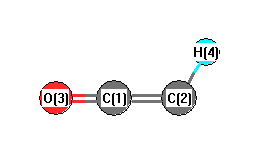Jump to
S1C2
Energy calculated at B2PLYP=FULL/aug-cc-pVTZ
| | hartrees |
|---|
| Energy at 0K | -151.885643 |
| Energy at 298.15K | |
| HF Energy | -151.701263 |
| Nuclear repulsion energy | 52.598882 |
The energy at 298.15K was derived from the energy at 0K
and an integrated heat capacity that used the calculated vibrational frequencies.
Vibrational Frequencies calculated at B2PLYP=FULL/aug-cc-pVTZ
| Mode Number |
Symmetry |
Frequency
(cm-1) |
Scaled Frequency
(cm-1) |
IR Intensities
(km mol-1) |
Raman Act
(Å4/u) |
Dep P |
Dep U |
|---|
| 1 |
Σ |
3486 |
3344 |
129.89 |
45.48 |
0.22 |
0.36 |
| 2 |
Σ |
2126 |
2040 |
330.22 |
16.08 |
0.06 |
0.11 |
| 3 |
Σ |
1301 |
1248 |
24.65 |
40.06 |
0.12 |
0.22 |
| 4 |
Π |
568 |
545 |
0.74 |
0.23 |
0.75 |
0.86 |
| 4 |
Π |
530 |
508 |
9.26 |
0.90 |
0.75 |
0.86 |
| 5 |
Π |
448 |
430 |
20.45 |
0.20 |
0.75 |
0.86 |
| 5 |
Π |
380i |
364i |
118.03 |
7.13 |
0.75 |
0.86 |
Unscaled Zero Point Vibrational Energy (zpe) 4038.9 cm
-1
Scaled (by 0.9594) Zero Point Vibrational Energy (zpe) 3874.9 cm
-1
See section
III.C.1 List or set vibrational scaling factors
to change the scale factors used here.
See section
III.C.2
Calculate a vibrational scaling factor for a given set of molecules
to determine the least squares best scaling factor.
Geometric Data calculated at B2PLYP=FULL/aug-cc-pVTZ
Point Group is C∞v
Cartesians (Å)
| Atom |
x (Å) |
y (Å) |
z (Å) |
|---|
| C1 |
0.000 |
0.000 |
0.020 |
| C2 |
0.000 |
0.000 |
-1.239 |
| O3 |
0.000 |
0.000 |
1.202 |
| H4 |
0.000 |
0.000 |
-2.297 |
Atom - Atom Distances (Å)
| |
C1 |
C2 |
O3 |
H4 |
| C1 | | 1.2591 | 1.1824 | 2.3165 |
C2 | 1.2591 | | 2.4415 | 1.0574 | O3 | 1.1824 | 2.4415 | | 3.4989 | H4 | 2.3165 | 1.0574 | 3.4989 | |
 More geometry information
More geometry information
Calculated Bond Angles
| atom1 |
atom2 |
atom3 |
angle |
|
atom1 |
atom2 |
atom3 |
angle |
| C1 |
C2 |
H4 |
180.000 |
|
C2 |
C1 |
O3 |
180.000 |
Electronic energy levels
Charges, Dipole, Quadrupole and Polarizability
Jump to
S1C1
Energy calculated at B2PLYP=FULL/aug-cc-pVTZ
| | hartrees |
|---|
| Energy at 0K | -151.888364 |
| Energy at 298.15K | |
| HF Energy | -151.702216 |
| Nuclear repulsion energy | 52.426417 |
The energy at 298.15K was derived from the energy at 0K
and an integrated heat capacity that used the calculated vibrational frequencies.
Vibrational Frequencies calculated at B2PLYP=FULL/aug-cc-pVTZ
| Mode Number |
Symmetry |
Frequency
(cm-1) |
Scaled Frequency
(cm-1) |
IR Intensities
(km mol-1) |
Raman Act
(Å4/u) |
Dep P |
Dep U |
|---|
| 1 |
A' |
3359 |
3223 |
42.45 |
78.12 |
0.29 |
0.46 |
| 2 |
A' |
2101 |
2016 |
387.54 |
7.86 |
0.16 |
0.28 |
| 3 |
A' |
1243 |
1193 |
6.07 |
40.15 |
0.15 |
0.26 |
| 4 |
A' |
570 |
547 |
36.68 |
3.24 |
0.72 |
0.84 |
| 5 |
A' |
508 |
488 |
213.79 |
1.89 |
0.05 |
0.10 |
| 6 |
A" |
505 |
484 |
2.03 |
0.34 |
0.75 |
0.86 |
Unscaled Zero Point Vibrational Energy (zpe) 4143.0 cm
-1
Scaled (by 0.9594) Zero Point Vibrational Energy (zpe) 3974.8 cm
-1
See section
III.C.1 List or set vibrational scaling factors
to change the scale factors used here.
See section
III.C.2
Calculate a vibrational scaling factor for a given set of molecules
to determine the least squares best scaling factor.
Geometric Data calculated at B2PLYP=FULL/aug-cc-pVTZ
Point Group is Cs
Cartesians (Å)
| Atom |
x (Å) |
y (Å) |
z (Å) |
|---|
| C1 |
0.000 |
0.050 |
0.000 |
| C2 |
1.081 |
-0.662 |
0.000 |
| O3 |
-1.076 |
0.514 |
0.000 |
| H4 |
2.126 |
-0.438 |
0.000 |
Atom - Atom Distances (Å)
| |
C1 |
C2 |
O3 |
H4 |
| C1 | | 1.2945 | 1.1718 | 2.1809 |
C2 | 1.2945 | | 2.4568 | 1.0684 | O3 | 1.1718 | 2.4568 | | 3.3403 | H4 | 2.1809 | 1.0684 | 3.3403 | |
 More geometry information
More geometry information
Calculated Bond Angles
| atom1 |
atom2 |
atom3 |
angle |
|
atom1 |
atom2 |
atom3 |
angle |
| C1 |
C2 |
H4 |
134.511 |
|
C2 |
C1 |
O3 |
169.905 |
Electronic energy levels
Charges, Dipole, Quadrupole and Polarizability
